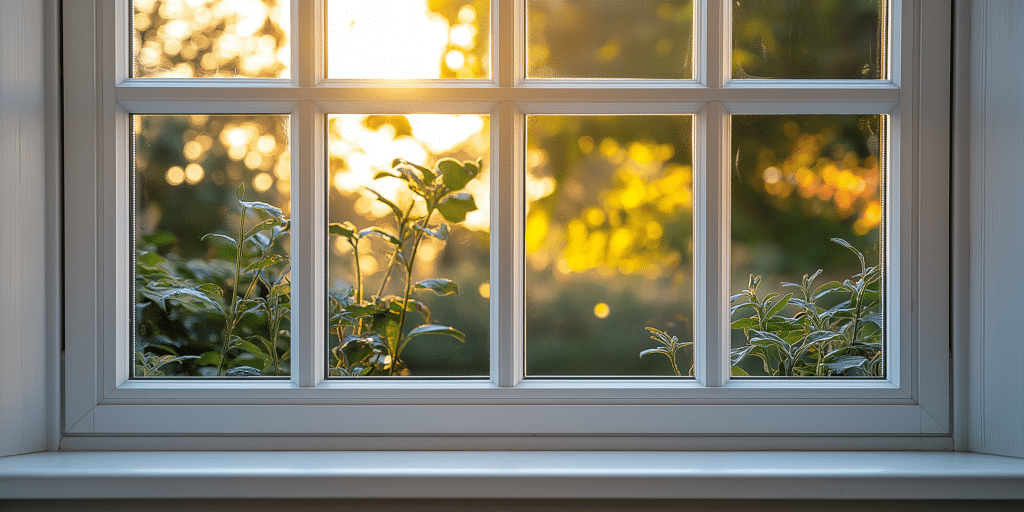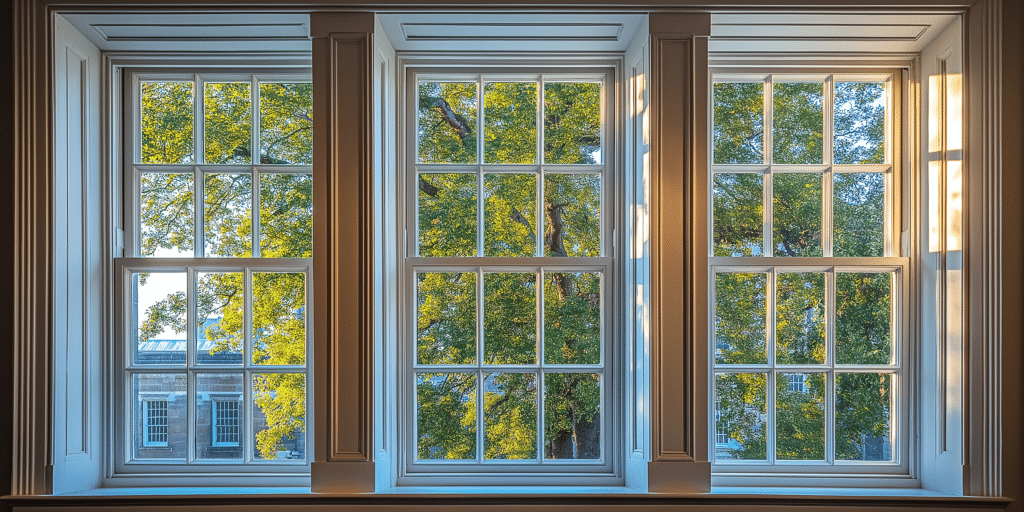Introduction to Sash Windows Glazing Bead

Sash window glazing bead not only provides a secure fit for the glass but also helps in weatherproofing and maintaining the window’s thermal efficiency.
According to a study by Glasgow Caledonian University, draught-proofing sash windows, which include the proper installation of glazing beads, can reduce draughts by almost 90%, significantly improving the energy efficiency of traditional sash windows.
Common materials include wood, uPVC, and aluminium. Each material offers different benefits, such as durability, ease of maintenance, and aesthetic appeal.
Glazing beads come in various profiles, including ovolo, lamb’s tongue, and chamfered, each contributing to the window’s appearance and performance in different ways.
Historical Significance of Glazing Beads in Sash Windows
The design and use of glazing beads have evolved significantly over time. Initially, glazing beads were crafted from timber and were integral to the classic Georgian and Victorian sash windows. Their role extended beyond mere functionality; they were also a decorative element, reflecting the architectural style of the period.
Timber glazing beads, as used in historical periods, are still preferred in conservation projects today due to their ability to preserve the heritage and architectural integrity of historic buildings.
In different historical periods, glazing beads were used to enhance the visual appeal of windows while ensuring that they met the insulation and weatherproofing standards of the time. Traditional glazing bead designs are still valued in conservation projects for their historical accuracy.
While modern beads often incorporate advanced materials for better durability and insulation, they still draw inspiration from traditional designs to maintain a classic aesthetic. The use of modern materials, such as uPVC and aluminium, provides enhanced durability and energy efficiency, while traditional timber is revered for its authentic appearance and compatibility with heritage properties.
Types of Glazing Beads for Sash Windows
There are several types of glazing beads used in sash windows, each offering unique benefits. The most common types include ovolo, lamb’s tongue, and chamfered beads.
Ovolo beads offer a rounded profile that adds a traditional look, while chamfered beads provide a more contemporary, clean line.
Lamb’s tongue beads, with their elegant curve, are often used in period properties to enhance both aesthetic and structural functionality.
Ovolo beads are aesthetically pleasing but may require more maintenance due to their intricate profile. Chamfered beads are easier to maintain and offer a sleeker appearance but may not be suitable for heritage properties. Lamb’s tongue beads offer a balance between traditional aesthetics and functional performance.
Ovolo beads are ideal for Georgian and Victorian homes, while chamfered beads suit modern properties, and lamb’s tongue is versatile enough for both traditional and contemporary settings.
Materials Used in Sash Window Glazing Beads

The choice of material for glazing beads significantly impacts the window’s durability, maintenance, and energy efficiency. Wood, uPVC, and aluminium are the most popular choices.
Wood offers a classic look but requires regular maintenance to prevent rot. uPVC is low-maintenance and durable, making it a popular choice for modern windows. Aluminium provides a sleek, contemporary appearance and is resistant to weathering, but it can be more expensive.
Consider the property’s architectural style, the local climate, and the maintenance requirements. Timber glazing beads are ideal for traditional homes, providing an authentic look, but may require more upkeep compared to uPVC or aluminium, which offer modern benefits such as increased energy efficiency and durability.
Wooden beads, while aesthetically pleasing, may not offer the same insulation as uPVC or aluminium, which can be designed to include thermal breaks that improve energy efficiency. uPVC, for example, is known for its energy-efficient properties, with modern designs often featuring multi-chambered profiles that enhance insulation.
The Functionality of Glazing Beads in Sash Windows
Glazing beads are not just decorative; they serve several functional purposes. They secure the glass within the sash, preventing it from shifting and ensuring a tight seal. This is crucial for maintaining the window’s overall stability. They hold the glass firmly in place, reducing the risk of rattling or breakage.
Nathan Diver, an expert in sash window restoration, emphasises that proper glazing bead installation is vital for both the aesthetic and structural integrity of sash windows, particularly in heritage properties. By creating a tight seal around the glass, glazing beads help prevent drafts and water ingress, enhancing the window’s weatherproofing capabilities.
Integrating draught-proofing into the sash window’s glazing beads can dramatically reduce heat loss and prevent moisture-related issues such as dampness and mould. Incorrectly installed glazing beads can lead to air leaks, water damage, and even compromised window security, emphasising the importance of professional installation.
Installation and Replacement of Glazing Beads
Installing glazing beads requires precision and care to ensure a perfect fit. The process typically involves measuring the window, cutting the beads to size, and securing them with nails or adhesive.
To remove old glazing beads, carefully pry them away from the sash using a putty knife, taking care not to damage the glass. Replacement involves fitting new beads and securing them in place.
Essential tools include a mitre saw, hammer, putty knife, and measuring tape. Materials might include wood, uPVC, or aluminium beads, nails, and adhesive. Ensuring the right tools are used is critical to achieving a secure fit that enhances the window’s overall performance.
Avoid cutting the beads too short, using the wrong type of adhesive, or failing to align the beads correctly, as these mistakes can compromise the window’s performance. As industry experts have highlighted, timely and correct installation of glazing beads is essential to avoid future issues such as drafts or loose panes.
Maintenance and Longevity of Glazing Beads

Proper maintenance is key to ensuring the longevity of glazing beads. Regular inspection for signs of wear and tear, such as cracks or warping, is essential. Cleaning the beads with a mild detergent and protecting them with appropriate finishes can extend their lifespan significantly, particularly in areas exposed to harsh weather conditions.
Look for cracks, looseness, or signs of water damage. If the beads are no longer securing the glass properly, it’s time for replacement. Delaying repairs can result in more extensive damage to the window structure and potentially higher repair costs.
Exposure to extreme weather, such as high humidity or freezing temperatures, can cause wood to warp or rot and make uPVC brittle. UV exposure, which can degrade certain materials over time, reducing their effectiveness and lifespan, is also important.
Use a soft cloth and a mild cleaning solution to clean the beads. For wooden beads, reapply protective finishes as needed to prevent water damage. Regular maintenance and timely repairs are the best strategies for extending the life of glazing beads, ensuring they continue to function effectively and maintain the aesthetic appeal of the sash windows.
Energy Efficiency and Insulation with Glazing Beads
Glazing beads play a crucial role in the energy efficiency of sash windows. By securing the glass tightly within the sash, glazing beads help to reduce heat transfer, keeping warm air inside during winter and preventing cool air from escaping during summer. This tight seal is essential for maintaining the window’s overall thermal performance.
Properly installed beads minimise gaps around the glass, which reduces heat loss and prevents condensation from forming on the window panes. This is particularly important in older properties where maintaining the original sash windows can be challenging without compromising energy efficiency.
Modern materials like uPVC and aluminium often include thermal breaks or insulating layers that improve the window’s overall energy efficiency. Innovations such as these help to bridge the gap between traditional aesthetics and modern energy standards, making them a popular choice for both new installations and restorations.
Advances in material technology, such as low-E coatings and argon gas-filled glazing units, can be combined with high-performance glazing beads to significantly improve insulation. These innovations provide homeowners with options to enhance energy efficiency while maintaining the aesthetic integrity of their sash windows.
Aesthetic Considerations for Sash Window Glazing Beads
The appearance of glazing beads can greatly influence the overall look of sash windows. The style and profile of the bead can complement or detract from the window’s design. For example, ovolo beads add a traditional charm, while chamfered beads offer a more contemporary look. These aesthetic choices are critical in preserving the historical value of period properties.
Custom glazing beads can be crafted to match the specific architectural style of the property, from ornate Victorian designs to sleek modern profiles. This level of customisation allows homeowners to maintain their homes’ architectural integrity while benefiting from modern advancements in glazing technology.
Glazing beads can enhance the building’s character and curb appeal by selecting a bead profile that aligns with the property’s historical or modern aesthetic. For instance, the use of lamb’s tongue profiles in Georgian homes adds an authentic touch that resonates with the building’s historical context.
Current trends include the use of sustainable materials, minimalist designs, and the incorporation of advanced insulating technologies to combine aesthetics with functionality. These trends reflect a growing interest in environmentally responsible design that does not compromise on the visual appeal of sash windows.
Common Issues and Solutions for Glazing Beads

Like any component of a window, glazing beads can encounter issues. These include warping, cracking, loosening, and damage from weather exposure. These issues can affect both the appearance and functionality of the windows, making it essential to address them promptly.
Warped or cracked beads should be replaced promptly to maintain the integrity of the window. Loose beads can often be re-secured with additional nails or adhesive. Regular maintenance and early intervention are key to preventing these problems from escalating.
Regular maintenance, including sealing and painting wooden beads, can prevent moisture ingress and warping. For uPVC and aluminium beads, periodic inspection and cleaning are sufficient to ensure they remain in good condition.
By selecting the right materials, ensuring proper installation, and maintaining the beads regularly, the long-term performance of glazing beads can be maximised. This proactive approach preserves the window’s appearance and functional efficiency.
Final Thoughts on Sash Windows Glazing Bead
Understanding the role of glazing beads is essential for anyone involved in sash window maintenance or restoration. Glazing beads are not just decorative; they are vital for securing the glass, providing insulation, and enhancing the window’s overall performance. This understanding is crucial for making informed decisions about window maintenance and restoration.
Selecting the appropriate material and design can improve the window’s energy efficiency, weatherproofing, and visual appeal. These choices are critical for ensuring that the windows perform well while complementing the property’s architectural style.
Key considerations include the material, architectural style, and local climate. Proper installation and regular maintenance are crucial for long-term performance. This holistic approach ensures that glazing beads contribute positively to the overall functionality and appearance of the windows.
As materials and technologies advance, glazing beads will likely continue to evolve, offering even better insulation, durability, and design options. These innovations will allow sash windows to preserve their historical charm while meeting modern energy efficiency standards.




